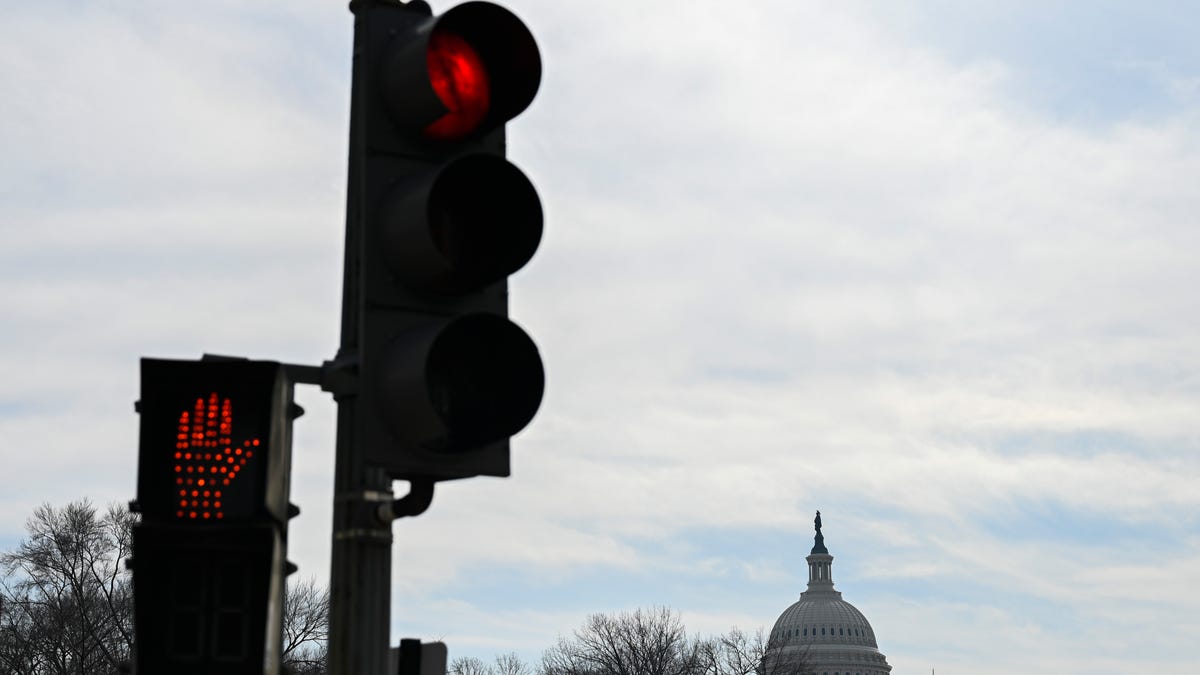Turning Right on Red Pits Environmental Concerns Against Safe Street Advocates

A red traffic light is seen near the US Capitol in Washington, DC on February 1, 2020.Photo: ANDREW CABALLERO-REYNOLDS / AFP (Getty Images)
“See this here? He’s turning right on a red. That is America’s only contribution to Western Civilization,” Jeremy Clarkson once said on an episode of Top Gear. Maybe he’s right. Turning on a red is a uniquely American style of driving with an interesting place in our push to conserve energy. But some want to see the red-white-and-blue practice of red light turning dismantled in the completely justified name of public safety.
The Ford Festiva Is a Car Worth Forgetting
Cities across the nation began letting drivers turn right on reds in the 1970s as a way to save on gas during the Oil Crisis, and it actually works, at least according to the Department of Energy:
Prior to the 1970’s, some states already allowed drivers to turn right on a red light, but many others – particularly in the eastern half of the country – did not. Then came sky-high prices at the pump (and gas-rationing) during the 1973 Oil Crisis and the 1979 Energy Crisis. During those years, the heightened cost of fuel coupled with the tough economic climate made citizens more aware of their energy usage on a national level. Policies like this one became more popular throughout the country.
[…]
The professionals over at UPS are also in on the fuel-saving secret. The major package delivery company requires their drivers to turn right whenever possible, and map their routes accordingly. In a 2008 interview, a UPS spokesperson told the Boston Globe that UPS drivers “are trained to map their routes to turn right whenever possible, [which] saves fuel and reduces emissions by minimizing the length of time our trucks are idling. And it’s safer too, because you don’t have to cross traffic.”
Our friends at StreetsBlog take a different approach to this history:
Rights-on-red are currently illegal throughout much of Europe, and they were also banned throughout much of the U.S. prior to the 1975 Energy Policy and Conservation Act, whose authors argued that the U.S. could cut down on emissions and fuel usage by allowing them. Under the law, states still can’t receive federal funding from what is now known as the State Energy Program unless they allow drivers to turn against the stoplight — despite the fact that the program, which was once helped states create sweeping energy conservation plans, is now largely used to weatherize buildings and isn’t even administered by the Department of Transportation.
[…]
Even before megacars became Americans’ favorite way to get around, though, right-on-reds still weren’t safe for vulnerable road users. As far back as 1982, researchers had already found that the law increased bicyclist crashes involving right-turning vehicles at signalized intersections as much as 82 percent in some states, while causing pedestrian crashes under those conditions to more than double in others.
[…]
…opponents of the proposed new law have claimed the council “lacks data” to prove that enough residents were saved from death and serious injury to justify taking the reform district-wide.The National Transportation Safety Administration made a similar argument in 1995, when it found that less than 1 percent of fatal and injury crashes on U.S. roads involved a right on red — though 22 percent of those crashes involved a bicyclist or pedestrian, and that person was injured a staggering 93 percent of the time, to say nothing of the harrowing impact of near-miss crashes that aren’t recorded in federal stats and might scare travelers off of active transportation entirely.
G/O Media may get a commission
While newer cars are EVs or equipped with fuel-saving stop-start technology, that certainly does not apply to the majority of vehicles on American roads, especially as the average fleet age continues to tick upward. Turning right on red could still be an important tool in our fight towards cutting down carbon emissions and saving money on volatile gas prices, but safety advocates say turning right on red needs to end to save lives.
And they are not wrong! Pedestrian deaths are skyrocketing, with 2021 hitting a four-year high of 7,485 pedestrians. Not all of these were at red lights, of course, but some of them were. As vehicles increase in both the size of their bodies and blindspots, pedestrians are more at risk than ever. Washington D.C. city council might outright ban the practice after unanimous approval of the Safer Intersections Act and safe streets advocates are hopeful it could serve as a frame work for cities across the country once again.
There are a lot of things to consider here, however. How much carbon or pollution will be caused by the cars that still need to idle at stop lights and how that might translate to increased risks of cancer and other health problems? Will lives or significant amounts of time be lost due to congestion issues that the right turns on reds currently mask and, if turning right on a red is punished by a fine, how can the weight of this fine fall equally on rich drivers as it does poorer city residents?
This is, as Ned Flanders would say, a dilly of a pickle. Sound off in the comments: would you rather live to walk another day or get through red lights quicker to save the planet?



